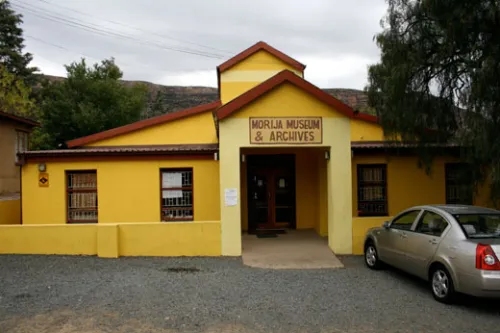Motsamai Mokotjo
Nestled in the heart of Lesotho, the Morija Museum and Archives stands as a testament to the nation’s rich history, artistry, and cultural heritage.
Established as the oldest surviving museum in Lesotho around 1956, this institution boasts extensive collections that span both archival documents and curated museum artifacts.
Beyond its tangible treasures, the museum is a hub of ongoing research endeavors and a dedicated publishing program, attracting scholars and enthusiasts from distant corners of the world.
The institution’s significance goes beyond artifacts; it sparks discussions about the Basotho people’s self-identity, nationhood, and the role of historical and art sites within their collective consciousness.
This significance became evident to me after a captivating conversation with Mpho Letima, the Director of the Gem Institute. Our dialogue explored the integral role that historical and artistic landmarks play in shaping the cultural fabric of societies, especially amongst the Basotho people.
As we delved into themes of self-identification within both colonial and pre-colonial contexts, a mosaic of humanistic values and national pride emerged.
This journey was deeply rooted in the writings of Thomas Mofolo, whose literary works substantiated the profound significance of “botho” – a concept encompassing heroism, faith, and a harmonious blend of cultures.
Situated just 44 kilometers from Maseru, Morija is a cornerstone that holds the potential to propel Lesotho towards remarkable strides, aligning with the aspirations set forth in the National Strategic Development Plan II (NSDP II).
This blueprint outlines a new trajectory for the nation’s growth, hinging on pivotal sectors including agriculture, manufacturing, tourism, and the creative industries to which Morija belongs.
Key Priority Area I, focusing on enhancing inclusive and sustainable economic growth while fostering private sector-led job creation, encapsulates this vision.
To substantiate this point: “Lesotho’s unique landscape provides boundless opportunity for serving as a backdrop to adventure movies, as well as hosting multi-sport, high-altitude training events, and a wider range of traditional leisure and adventure activities.
“The creative industries remain largely informal, and no baseline data currently exist on industry employment. The industry includes fine arts, films, theatre productions, music, fashion, and literary arts.â€
NSDP II underscores the intrinsic value of Lesotho’s distinctive landscape, presenting boundless opportunities for its utilization as a backdrop for adventure films, hosting high-altitude training events, and offering an array of traditional leisure and adventure activities.
Amidst this landscape lies the creative industries, a sector characterized by its informal nature and a lack of comprehensive data on industry employment.
Encompassing fine arts, films, theatre productions, music, fashion, and literary arts, this sector assumes a vital role in the nation’s cultural narrative.
However, challenges persist within the creative industries. Participation in music is skewed towards men, while crafts are predominantly pursued by women. Many artists export their products to international markets such as South Africa, the United States, Kazakhstan, and Canada according to NSDP II.
Yet, industry competitiveness remains hampered by issues such as piracy, insufficient protection of intellectual property rights and indigenous knowledge, lack of coordination among agencies supporting creative industries, dearth of formal training resulting in lower product quality, limited business and marketing acumen, inadequate infrastructure support, restricted funding sources, and the marginalization of creative arts in national policies and plans.
The sector also grapples with fragmented production and a lack of organized collection centres.
This is the overarching policy landscape, inviting us to embark on a tangible journey to Morija.
One venture to assess the state of affairs within this trajectory.
The views and insights of politicians and stakeholders offer invaluable perspectives, shedding light on how the institution appears in their eyes and how it aligns with their visions for how the country’s cultural and economic development.
Elitists have failed drastically.
However, Morija Museum and Archives stands as a beacon of Lesotho’s history, culture, and creative spirit. Its existence carries profound significance in terms of preserving the nation’s heritage, fostering artistic expression, and contributing to Lesotho’s economic growth.
As we navigate the terrain of the NSDP II and the challenges outlined within the creative industries, Morija emerges as a symbol of hope and potential. This historical and artful haven beckons us to explore, engage, and envision a future where Basotho heritage flourishes, creativity thrives, and the nation stands proudly on the global stage.
“Multiple sites were identified for tourism development area feasibility studies: Letša-la-Letsie, Semonkong, and Sani Top. Master plans were developed, and four potential sites for the development of visitor centres were identified (i.e., Morifi, Thaba-Tseka, Monontsa, and Marakabei). In an effort to develop market outlets for local tourism product value chains, 11 tour excursionists (based in Maseru) and 16 tour guides (based in Kome, Malimong, Thaba-Bosiu, and Ha-Baroana) were trained. Linkages with South African tour operators Clarence, Vaal, Underberg, and Bloemfontein were formed. Additionally, 20 crafters and 89 rural homestay owners from eight communities were trained.
“Lesotho’s star grading system was implemented to help improve the quality and is currently under review for additional modifications. Sixteen accommodation facilities have been graded to date. To improve the marketability and visibility of Lesotho as a destination of choice for tourists, the country developed the Lesotho Tourism Positioning and Communication Strategies, as well as the Lesotho tourism brand.
The brand has been introduced through activities including the engagement of a public relations agency to increase awareness of Lesotho in the South African market, and promotion of tourism events such as the Lesotho Sky, Afri-Ski King’s Cup, Ultra Trail Marathon, Lesotho Tourism Festival, and Kome Beer Festival.
“In 2013, Lesotho recognised many achievements: the Sehlaba-Thebe National Park was listed as a World Heritage Site; 65 other heritage sites were documented; 20 craft companies were trained and empowered to export to the United States, the Lesotho tourism brand was launched; the State of the Environment Report for 2014 was produced; and 187 environmental impact assessment certificates were issued in mining, agriculture, business enterprises, roads, filling stations, factories, and buildings. As a strategy to protect, conserve, and manage cultural heritage resources, Lesotho commenced the construction of the National Museum and Art Gallery in 2015, and construction is anticipated to be complete by the end of 2019,†NSDP II records.
Where’s Morija in the mix?
Summary
- Nestled in the heart of Lesotho, the Morija Museum and Archives stands as a testament to the nation’s rich history, artistry, and cultural heritage.
- Yet, industry competitiveness remains hampered by issues such as piracy, insufficient protection of intellectual property rights and indigenous knowledge, lack of coordination among agencies supporting creative industries, dearth of formal training resulting in lower product quality, limited business and marketing acumen, inadequate infrastructure support, restricted funding sources, and the marginalization of creative arts in national policies and plans.
- The views and insights of politicians and stakeholders offer invaluable perspectives, shedding light on how the institution appears in their eyes and how it aligns with their visions for how the country’s cultural and economic development.

Your Trusted Source for News and Insights in Lesotho!
At Newsday Media, we are passionate about delivering accurate, timely, and engaging news and multimedia content to our diverse audience. Founded with the vision of revolutionizing the media landscape in Lesotho, we have grown into a leading hybrid media company that blends traditional journalism with innovative digital platforms.







